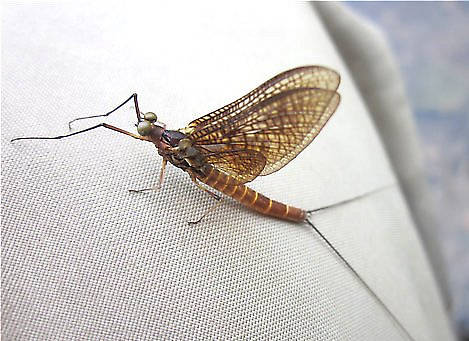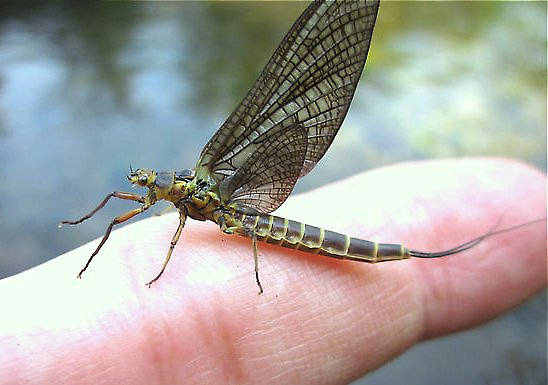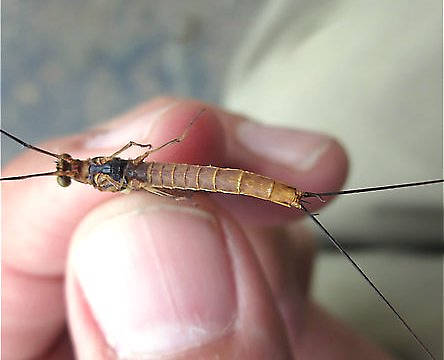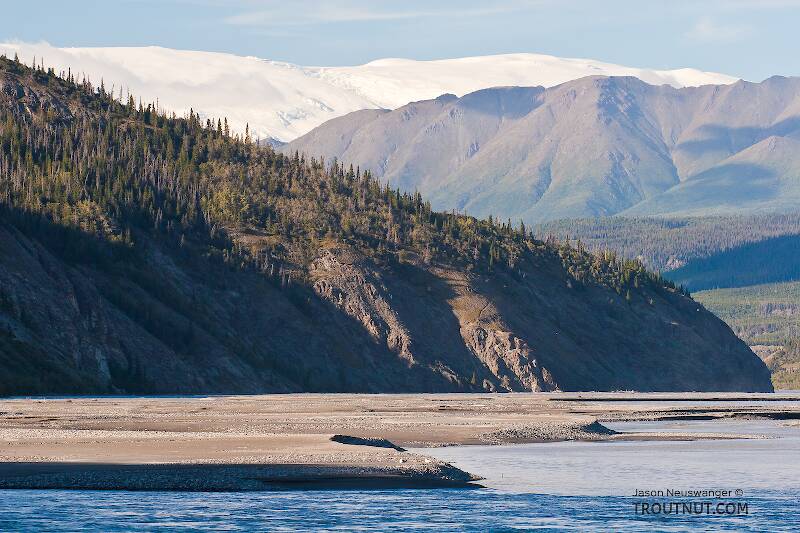
Salmonflies
Pteronarcys californica
The giant Salmonflies of the Western mountains are legendary for their proclivity to elicit consistent dry-fly action and ferocious strikes.

I'm calling this one Pycnopsyche, but it's a bit perplexing. It seems to key definitively to at least Couplet 8 of the Key to Genera of Limnephilidae Larvae. That narrows it down to three genera, and the case seems wrong for the other two. The case looks right for Pycnopsyche, and it fits one of the key characteristics: "Abdominal sternum II without chloride epithelium and abdominal segment IX with only single seta on each side of dorsal sclerite." However, the characteristic "metanotal sa1 sclerites not fused, although often contiguous" does not seem to fit well. Those sclerites sure look fused to me, although I can make out a thin groove in the touching halves in the anterior half under the microscope. Perhaps this is a regional variation.
The only species of Pycnopsyche documented in Washington state is Pycnopsyche guttifera, and the colors and markings around the head of this specimen seem to match very well a specimen of that species from Massachusetts on Bugguide. So I am placing it in that species for now.
Whatever species this is, I photographed another specimen of seemingly the same species from the same spot a couple months later.

Mayfly Species Litobrancha recurvata (Dark Green Drakes)
Where & when
Litobrancha recurvata is abundant in fewer places than other important Ephemeridae like Hexagenia limbata or Ephemera simulans, but where it does exist it has dense populations which produce good hatches. It's distribution is largely eastern, from Pennsylvania though the New England states, but it is reported for Minnesota and both Wisconsin and Michigan have good populations. They are also reported down into the mid-Atlantic states.Emergence begins in late May in Pennsylvania. Michigan and Wisconsin follow a week or so later and peak in June. The hatch may continue through July and even into August to the north. It only lasts from three to five days on a given stretch of stream.
In 9 records from GBIF, adults of this species have been collected during June (44%), July (44%), and May (11%).
Species Range
Spinner behavior
Time of day: Dusk
Nymph biology
Current speed: Slow
Substrate: Firm silt
Environmental tolerance: Intolerant of warm water or pollution
They take two to three years to mature before hatching.
Physical description
Most physical descriptions on Troutnut are direct or slightly edited quotes from the original scientific sources describing or updating the species, although there may be errors in copying them to this website. Such descriptions aren't always definitive, because species often turn out to be more variable than the original describers observed. In some cases, only a single specimen was described! However, they are useful starting points.
Male Spinner
Wing length: 15-18 mm
Wings heavily tinged with dark reddish brown; abdomen pale yellowish brown, dark markings few and inconspicuous; tips of penes narrow, recurved.
Head red-brown; carina, basal antennal joints and tip of filament paler. Eyes yellowish above; separated by space equal to about half diameter of one eye. Pronotum light red-brown; lateral margin narrowly darker; lateral stripes very narrow, indistinct. Mesothorax and metathorax deep reddish to blackish brown; faint yellowish markings along postero-lateral margin of mesonotum and on a small area anterior to scutellum. Creamy white markings on pleura below wing roots and around bases of legs. Ventral area of fore coxa pale reddish; upper part of coxa, trochanter and femur yellowish red; tibia pale red-brown; tarsus greyed lavender, the claws, tip of distal joint and bases of middle joints narrowly paler. Middle and hind legs yellowish; coxae red-brown; tarsi very faintly grey-tinged; tarsal joinings narrowly purplish grey. Wings heavily tinged with reddish or purplish brown, leaving hyaline areas only at base of each wing, and beyond disc and near apex of fore wing. Veins blackish; cross veins of both wings rather widely margined with dark red-brown, in dark areas. Outer margin of hind wing not darker than adjacent areas.
Abdomen pale yellowish brown; segment 1 light red-brown; sternites slightly paler than tergites. Pleural fold and posterior margins of all segments paler; tergites with very faint grey mid-dorsal line, narrow on basal ones, somewhat wider apically. Faint semi-opaque yellowish triangles based on posterior margins may be visible. A brownish line on each spiracular area. On each sternite, an oblique brownish sub-median streak from anterior margin on each side, and two dark dots near center, one on each side. No other dark markings. Tails light purplish brown; joinings darker, each preceded by a narrow paler ring. Forceps base, basal forceps joint and penes pale reddish; remainder of forceps greyed lavender. Penes distinctive, the distal third of each narrowed and recurved. Basal forceps joint short and stout, second joint relatively long and incurved apically; distal joints normally well developed (see fig. 84). The distinctive recurved tips of the penes, and the brown-tinged wings reminiscent of Ephemera guttulata distinguish this from other species of the genus. Nymph shown in fig. 47.
Specimens of the Mayfly Species Litobrancha recurvata
1 Male Dun

1 Female Dun

1 Male Spinner

Discussions of Litobrancha recurvata
A quick look at the head and tusks is pointing me to Litobrancha recurvata, and the emergence period shown in Hatches II for them is about right (May 14 to July 3). The photo they have in their color plates looks very close to what I just finished photographing, but what I have looks different.
I took a couple dozen quick photos of it and uploaded them to my flickr account, wasn't sure if it was ok or necessary to upload them all here. Link to the gallery below. Please let me know if you'd like me to upload any of these here, or if you'd like a better shot of a certain feature, so you can see the full res photo for better detail. In my non-expert opinion, I would say this nymph is near full maturity, as its ginormous. I can't find my metric ruler, but it is ~50mm long. Thanks for any help.
http://www.flickr.com/photos/cerveniak/sets/72157633180659254/
Alex
From my experience collecting and rearing these critters, they have a 2-year life cycle in PA and MD. They increase tremendously in size in their second year. Emergence occurred in late May into early June about a week before that of green drakes (Ephemera guttulata).
Start a Discussion of Litobrancha recurvata
References
- Arbona, Fred Jr. 1989. Mayflies, the Angler, and the Trout. Nick Lyons Books.
- Caucci, Al and Nastasi, Bob. 2004. Hatches II. The Lyons Press.
- Fauceglia, Ted. 2005. Mayflies . Stackpole Books.
- Knopp, Malcolm and Robert Cormier. 1997. Mayflies: An Angler's Study of Trout Water Ephemeroptera . The Lyons Press.
- Leonard, Justin W. and Fannie A. Leonard. 1962. Mayflies of Michigan Trout Streams. Cranbrook Institute of Science.
- Needham, James G., Jay R. Traver, and Yin-Chi Hsu. 1935. The Biology of Mayflies. Comstock Publishing Company, Inc.
- Schwiebert, Ernest G. 1955. Matching the Hatch. MacMillan Publishing Company.
Mayfly Species Litobrancha recurvata (Dark Green Drakes)
Species Range
Common Names
Resources
- NatureServe
- Integrated Taxonomic Information System
- Global Biodiversity Information Facility
- Described by Morgan (1913)





